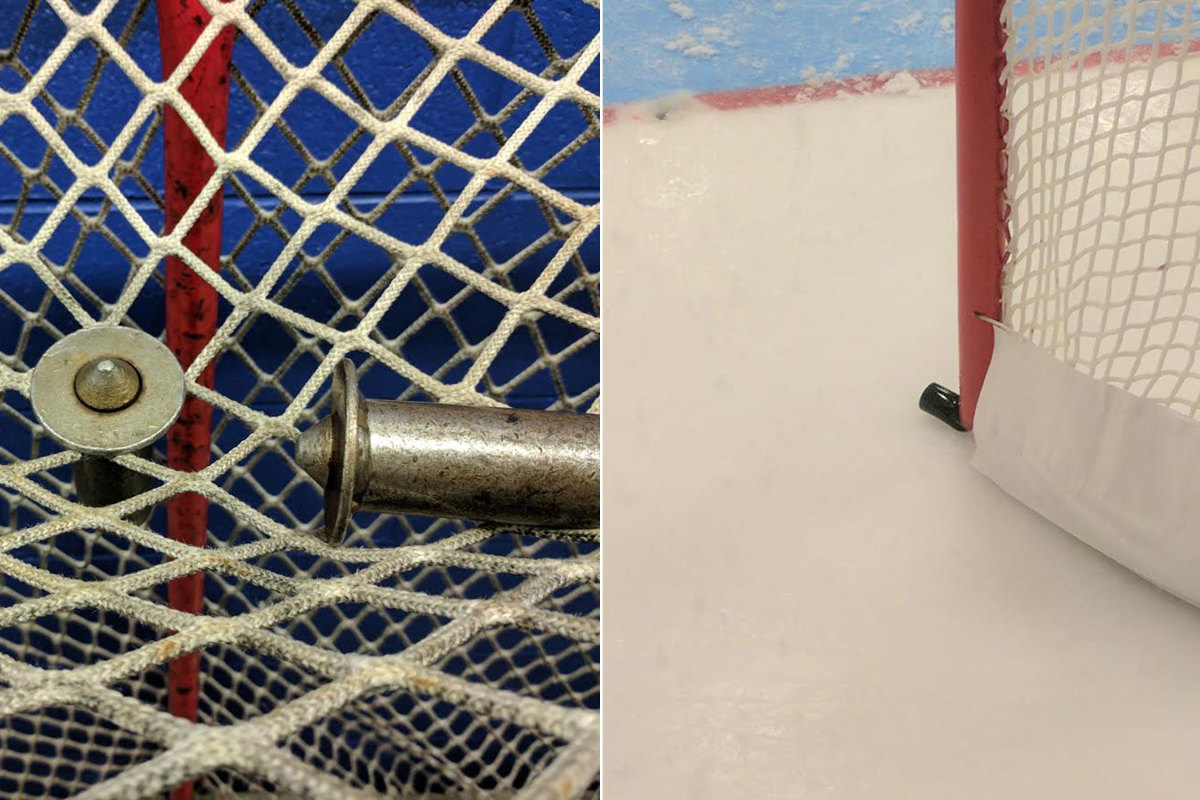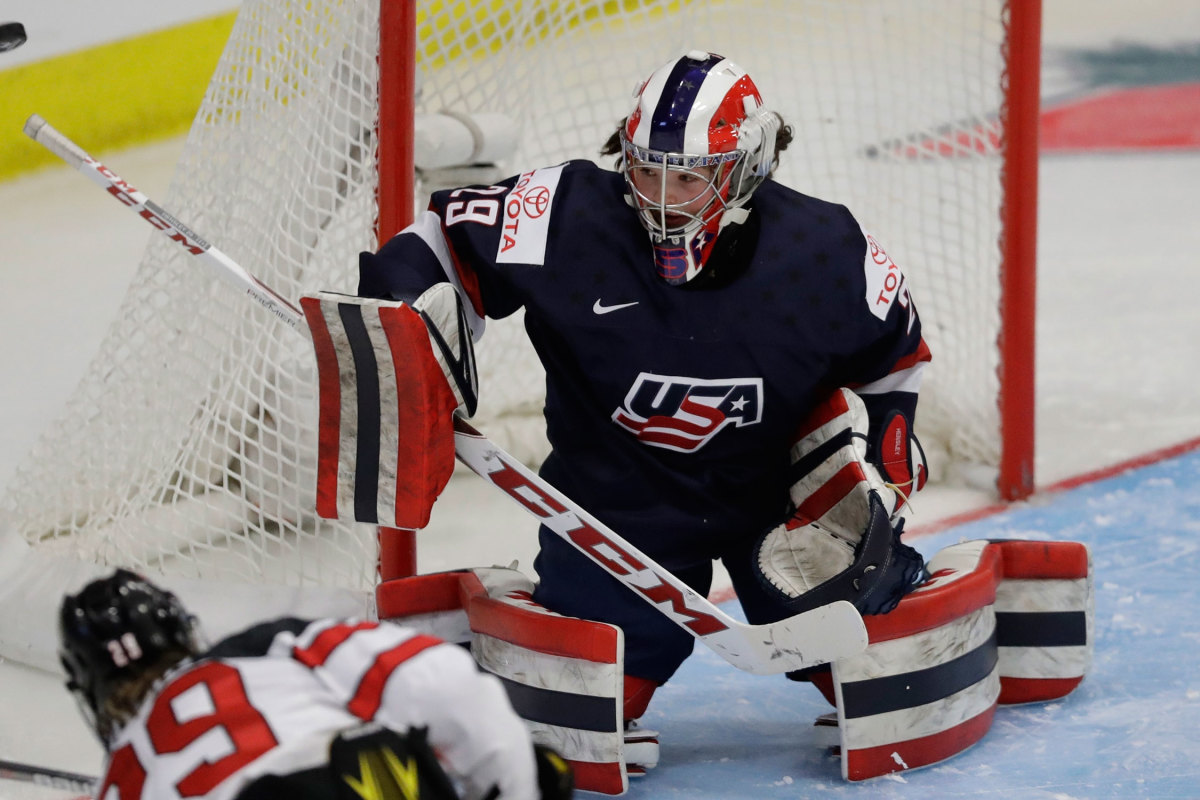Women's Worlds Notebook: Raty raises questions after Finland's opening loss

PLYMOUTH, Mich.—Russia topped Finland thanks to a last-minute power play goal in the teams’ Women’s World Championship opener, though there was some controversy regarding conditions on the tournament’s secondary rink.
Finnish goalie Nora Räty was the first player to enter the mixed zone after the loss and was visibly upset. Her eyes were red and wet and her voice shook as she berated the rink conditions, specifically the break pins used to hold the nets in place.
“We can’t push off the post since they come off so easily,” she said. This would never happen on the men’s side, it should never happen here. The nets are absolutely awful. That’s why they scored the second goal because I could not push off of the post because the nets come off.”
An investigation of the secondary rink after play had ended showed sets of break pins, something several players, including Räty, confirmed are not normally used during high level competition. The goals on the main rink used rubber pegs commonly called Marsh Pegs. Räty confirmed the break pins were used during her game and referred to them as the kind of pegs used in beer leagues.
“It’s fricking bullsh— that we have nets like this,” she said. “It’s absolutely a joke that we play with nets like that; that don’t have the pegs they should have. For the organizers, it’s absolutely bullsh—. Because goalies can’t play their games like that.
2017 Women's World Championship: Breaking down the tournament field
“I tried to push off the post, the net is off and I’m just stuck there. I weigh about 150 pounds. It should not be doing that with my weight. It’s absolutely a joke. It can’t happen at this level.”
Per IIHF rule 20(iv): “For top-level IIHF competitions, flexible goal pegs to hold the frame in place but which displace the goal net from its moorings upon significant contact are mandatory.”
The rule would seem to imply that the break pins do not meet that standard, but the only comment USA Hockey Director of Communications Dave Fischer would make on the situation was that the rinks were approved by the IIHF.
While there’s a size difference between the two rinks—the main is NHL-sized at 200 feet by 85 and the secondary rink is Olympic-sized at 200 by 100—Räty said the net, and by extension their pegs, were not up to standard.

“It ruins my day when I have to deal with nets like that,” she said. “That should not be happening at this level. I’m 100% sure that last goal would not have happened if we had real nets. But that’s life.”
Canadian goalie Shannon Szabados said after the U.S.—Canada game played on the main rink that she did not feel she had any difficulty pushing off the posts.
Attempts to reach the IIHF for comment were unsuccessful. We will update this story as it continues to evolve.
United States 2, Canada 0
The Americans proved a lot of naysayers (myself included) wrong by not only beating Canada, but putting together a full 60-minute game that showcased their speed and fitness. Coach Robb Stauber said he wants to focus on pace and being aggressive, and the players have taken it to heart.
After the boycott ended but before the puck dropped, multiple members of the team said they thought the bond they’d created through the fight with USA Hockey would translate to the ice. I was among the skeptics, but the Americans looked better on the ice Friday night than they have in recent memory.
Putting proof to their claims of chemistry, Megan Bozek and Brianna Decker combined on USA’s first goal in a seamless manner. Bozek carried the puck down the boards and circled behind the net. Decker crashed toward the far post and was in perfect position to receive Bozek’s pass as she rounded the net.
A beautiful rush by Bozek sets up this Decker goal for Team USA. 1-0 #WWC2017 #WomensWorlds pic.twitter.com/18cEG5EMIZ
— Women's Hockey Gifs (@CWHLHighlights) April 1, 2017
“The chemistry on our team is great. You know where people are going to be on the ice, when to expect the puck, when you know the back check is coming. It just speaks to the power of the team,” said Bozek.
USA returns to the ice on Saturday at 3:30 pm ET against Russia. Canada faces Finland at 7:30 pm ET.
Nicole Hensley gets the call in net
Many believe Alex Rigsby is the current No. 1 goalie for Team USA, but it was Nicole Hensley who got the start in the key meeting with its biggest rival. It was a purposeful and tactical evaluation move by Stauber. Though he’s very confident in their goaltending corps, he wanted to see how Hensley would fare in this high-pressure situation.
“We wanted to put her in the heat of the battle,” he said. “She’s a quality goalie and we want to see her against the best in the world. It’s always great to get a look at somebody like that in a high pressure situation. She was solid. You could see a lot of calmness to her game in a situation that was pretty heated. She stood tall,” he said.

Switzerland 2, Czech Republic 1 (SO)
Switzerland came out a little flat and the Czechs showed they are more than capable of keeping up. Tereza Vanisova stood out for Czech Republic; the Maine freshman was active all over the ice and scored the team’s lone goal. Swiss goalie Florence Schelling was far from her net to clear a puck and Vanisova intercepted it near the blue line and scored from distance.
Alina Muller and Christine Meier had outstanding games for the Swiss, taking some pressure off Lara Stalder and giving them depth. Evelina Raselli scored the game-tying goal on the power play with just 3:45 left in the game. The Swiss took their timeout to set up the power play and executed it exactly as drawn up.
The teams played a scoreless 3-on-3 overtime period and the shootout went five rounds before Meier scored. Schelling blocked the final Czech attempt to give the Swiss the two points.
Czech Republic faces Germany at 12 pm ET on Saturday. Switzerland plays Sweden at 6 pm ET on the secondary rink.
'We need to be brave enough to stand up': U.S. women’s hockey players on their fight for equal pay
Schelling on recovering from the mistake that led to the Czech goal:
“I forced myself to go and play the puck after that happened because it is my game and the players are used to me playing the puck, so I felt like it would be worse if I were to stop going out of the net. It was difficult at first but then I was like ‘I know I can do this.’ It was just a bad mistake. It happens.”
Growth for the Czechs
The opening game of the tournament was a near identical rematch of an Olympic qualifying game between Switzerland and Czech Republic that took place in February. The Swiss won 4-1 and the Czechs did not qualify. Though they didn’t get revenge, Friday’s effort showed growth for the young Czech club. They dominated the early part of the game and kept sustained pressure on the Swiss, forcing them to get creative. They forced the Swiss to win it in overtime and as far as moral victories go, this has to be up there. I expected the Czechs to be fun to watch, but thought they might need a few more years before they are truly competitive. They proved on Friday that their ability to be a true threat is just right around the corner
Germany 3, Sweden 1
Germany came to Plymouth finishing up a disappointing season. The team failed to qualify for the Olympics, but captain Julia Zorn said the Germans are focused on making the best of this tournament experience and growing as players as they go.
“We came here as a team that got promoted last year. Our goal is to play the best hockey possible in each game. It worked out today, but that doesn’t mean it will work out tomorrow. Tomorrow is a new day. Maybe the points from today don’t matter,” she said.
The Germans cut three forwards off their roster and came to Plymouth with 10 forwards and 10 defensemen. It seemed like a decision meant to indicate the style of play we’d see from them, but that wasn’t the case on Friday. They out-shot Sweden 33-23 and won on the back of goals scored :21 apart in the second period.
On paper, they seemed to be looking to be a defense-first team, but Manuela Anwander said that just because something says defense on paper, doesn’t make it so.
Anwander scored Germany’s second goal with a slap shot off the face-off on Grahn’s right side. Laura Kluge won the faceoff and pushed the puck between her legs and back to Anwander, who wound up and beat Swedish goalie Sara Grahn, who didn’t even see it.
With new deal, U.S. women's team looking forward to World Championships—and beyond
Anwander said that throughout the season she had been focused on making a play with the puck off the face-off and she had specifically been working to be more focused on taking a shot if the opportunity was there.
Andrea Lanzl followed up just :21 later to extend the lead. She roofed a shot past Grahn, but much of the credit on the goal has to go to Zorn, who got the read on a lazy Swedish pass in the zone and jumped up to intercept it. She hit Lanzl in stride for an easy goal.
According to Anwander, the Germans’ familiarity with the Swedes helped them to know what mistakes they needed to avoid and Zorn said it helped her to know what kind of breakout they have. Her linemates helped circle them to the far boards and she was easily able to read the pass and intercept it.
Germany will face Czech Republic at 12 pm ET on Saturday. Sweden meets Switzerland at 6 pm ET on the secondary rink.
